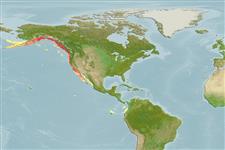Crinoidea |
Comatulida |
Antedonidae
Environment: milieu / climate zone / depth range / distribution range
Ecology
Sessile; depth range 11 - 1252 m (Ref. 78719). Temperate
Eastern Pacific.
Length at first maturity / Size / Weight / Age
Maturity: Lm ? range ? - ? cm Max length : 25.0 cm H male/unsexed; (Ref. 865)
It is found on soft and hard bottoms in subtidal areas (Ref. 865).
Life cycle and mating behavior
Maturity | Reproduction | Spawning | Eggs | Fecundity | Larvae
Members of the class Crinoidea are gonochoric. During spawning, the pinnule walls rupture and the eggs and sperms are shed into the seawater. Life cycle: Embryos elongate into free-swimming larvae (doliolaria) which later sink to the bottom where they metamorphose into stalked sessile crinoid.
Lambert, P. 2007 Checklist of the echinoderms of British Columbia (April 2007). http://www.geog.ubc.ca/biodiversity/efauna/documents/EchinodermsofBCChecklist.pdf (Ref. 78719)
IUCN Red List Status
(Ref. 130435: Version 2025-1)
CITES status (Ref. 108899)
Not Evaluated
Not Evaluated
Threat to humans
Human uses
| FishSource |
Tools
More information
Trophic EcologyFood items (preys)
Diet composition
Food consumption
Predators
Population dynamicsGrowthMax. ages / sizesLength-weight rel.Length-length rel.Length-frequenciesMass conversionAbundance Life cycleReproductionMaturityFecunditySpawningEggsEgg developmentLarvae PhysiologyOxygen consumption
Human RelatedStamps, coins, misc.
Internet sources
Estimates based on models
Preferred temperature
(Ref.
115969): 3.9 - 8.1, mean 5.5 (based on 89 cells).
Fishing Vulnerability
Low vulnerability (15 of 100).
Price category
Unknown.
